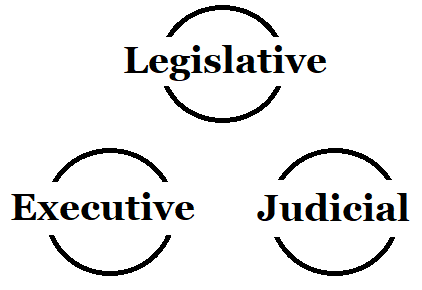Constitutionalism
Constitutionalism refers to the practice of establishing and upholding constitutions, covenants or treaties instituting an association of component parts and their means of governance. Very ancient in origin, in the Anglo-American world its roots are generally traced to the establishment of Magna Carta, wherein lower barons put governing limitations on the King and his men, thereby establishing the beginnings of a constitutional monarchy, something that would culminate in the English Civil War and other conflicts such as the American Revolution, which transitioned instead to a constitutional republic.
Constitutionalism is, today, in the United States anyway, especially associated with efforts to maintain the established, conservative values arising from out of Enlightenment liberalism against the encroachments of illiberal philosophies such as Marxism, fascism, and progressivism. Appeals to the Constitution are often made, in particular to the Bill of Rights, which outline fundamental rights and protected liberties that are not supposed to be infringed upon. Constitutions serve the duty of allocating such things as rights, privileges, duties, and responsibilities.
Classical Republicanism
In classical republican thinking, following after philosophers such as Montesquieu, the concepts of “checks and balances” and of tripartite government have become well-established, particularly through the American system of government. In the American system of government, the tripartite system of checks and balances is that of the Legislative Branch, the Executive Branch, and the Judicial Branch.
The Legislative Branch makes the laws. The Executive Branch implements the laws. And the Judicial Branch enforces the laws. Importantly, each does so distinctly from one another. This distinction between the roles of the branches of government is what is referred to as a system of checks and balances, because each branch has limitations to its powers.
Historically, republics have tended to be more oligarchic than democratic, having influence reserved to a select few elites.

Direct-Democracy
Direct-democracy, theorized of variously by thinkers as diverse as Spinoza and Rousseau, refers to a system by which Legislation, at least, and sometimes even the other branches of government, is undertaken directly by the people. That is, in a direct-democracy, every major issue that may arise gets addressed by the people at-large through a vote. This might occur by way of a general or delegate assembly, or through some other means of communication such as a bulletin or by initiative and referendum.
In a directly-democratic republic, the Legislative Branch functions as something like a general assembly, with the executive and judicial branches ultimately being accountable to it. Typically, arrangements such as this are reserved for direct participation in the Legislative by an aristocracy, such as in a Golden Democracy sort of arrangement, where only nobles could vote, or how the Articles of Confederation functioned for the early United States, where only major landowners could vote. A directly-democratic republic that is truly democratic, that is, truly run by the people, would be one in which every citizen could vote on legislative and elective matters directly.
Technocracy
Technocracy is a current than follows after thinkers such as Saint-Simon and Comte, which supports the governance of society by scientists and other intellectuals and their use of technology. A sort of hybrid development from out of bureaucracy and ocholcracy, it would move toward a system of secondary adhocracy directed ultimately by planist means utilizing statistics.
In today’s terms, technocracy has become synonymous with the use of technologies such as “artificial intelligence” to perform administrative tasks for the techno-managerial class, a cultural Marxist or fascist bunch that ultimately answers to synarchic or Illuminati interests, the “20 percent” that work for the “one percent,” being composed variously of naves and dupes, being more “navey” the higher up in the pyramid scheme.
Anarchism
Government is that body of people who control the state, a monopoly on the legitimate exercise of violence. In other words, government is that group of people who can commit violence without recompense, there being no other recognized legitimate body capable of using it. States, in the hands of governments, hold a monopoly on legitimate violence, but they can refrain from the exercise of legitimate violence and they can use illegitimate violence owing to their monopoly on violence. Governing parties are known as –archs of some form or another, such as mon-arch, olig-arch, and so forth, representing -archy, meaning a ruling class.
Where a ruling class, or government, does not exist, a state cannot exist, because a monopoly on violence cannot exist if everyone can participate in it. This condition is known as anarchy. Whereas monarchy means “one ruler,” and oligarchy means “few rulers,” an-archy means “no rulers.” This does not mean that nobody rules, but that rules that do exist are consented to and are arrived at mutually. Where an anarchy exists, there is no body of individuals who can commit violence with the assumed consent of others arising from their duress.
Ambiarchy as a Directly-Technocratic Anarchist Republic
Ambiarchy would function as a directly-technocratic, constitutional anarchist republic. What this means is that the techno-managerial class would compose the Executive Branch of a voluntary association and would answer to the general membership, who, by way of a general assembly or similar institution, would legislate terms that would be translated into code for the membership, which would function as the Judicial Branch, the codes being equivalent to statutory law. No codes would be allowed which go against the constitution of the republic, thereby protecting the anarchist elements of freedom of conscience, freedom of speech, freedom of association, freedom of exchange, and so on. This would establish direct, classless rule by society, utilizing technology, a directly-technocratic, constitutional anarchist republic.

